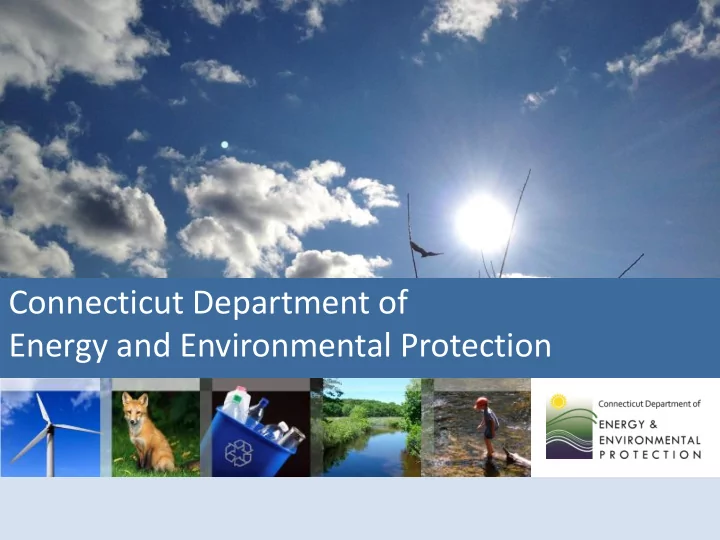

Connecticut Department of Energy and Environmental Protection
Connecticut’s Perspective on the NRC Staff’s Recommendations and Additional Views on Transformation for the Agency October 29, 2018 Jeff Semancik Director, Radiation Division Connecticut Department of Energy and Environmental Protection Public Commission Briefing on Transformation at the NRC Connecticut Department of Energy and Environmental Protection
Insights on Transformation • CT applauds the NRC’s Transformation Efforts • Focus must remain on Safety • Nuclear Safety Risk Should be Managed not Accepted • Regulatory Decisions should be based on Best Science and Facts • Engage the Communities that Bear the Risk Connecticut Department of Energy and Environmental Protection Connecticut Department of Energy and Environmental Protection
NRC Transformation Efforts • We recognize reality is driving change – Obligation to align limited resources and available funding with the degree of safety, security, and environmental protection they achieve – Requires innovative solutions and cooperative actions • We understands that there will impact. – Imperative that the NRC continues to work collaboratively with all stakeholders including states, local communities, special interest organizations, and other federal partners, as well as the regulated industry to communicate changes and minimize the adverse effects Connecticut Department of Energy and Environmental Protection Connecticut Department of Energy and Environmental Protection
Focus must remain on Safety • SECY-18- 0060…. – Proposals have an implied assumption that we are being too safe (i.e. “overly conservative ”) – References to “the difficult market conditions for the nuclear industry” (p.8) • Nuclear safety culture principles remind us that, “For the commercial nuclear power industry, nuclear safety remains the overriding priority” – Inconsistent with, “Move fast and break things” culture associated with innovation in Silicon Valley – Focus must remain on improving or maintaining Public Health and Safety and minimizing environmental impact Connecticut Department of Energy and Environmental Protection Connecticut Department of Energy and Environmental Protection
Risk Should be Managed not Accepted • SECY-18-0060 states, “…the agency must accept a greater degree of risk and uncertainty…” (p. 5) and discusses “…increasing risk tolerance…” (p.7) – Simply accepting higher risk is a “sucker’s choice” – States and local communities not regulatory agencies are the ones that bear the risks and should determine if it is acceptable – Who is accountable when the improbable occurs? • Increase accountability for risk based decisions • For example, individual licenses held by reactor operators helps ensure individual accountability for their actions. Consider similar personal license or certification for 10 CFR 50.59 evaluators. Connecticut Department of Energy and Environmental Protection Connecticut Department of Energy and Environmental Protection
Risk Should be Managed not Accepted • Risk should be managed vice accepted 𝑄𝑠𝑝𝑐𝑗𝑚𝑗𝑢𝑧 𝑝𝑔 𝑃𝑑𝑑𝑣𝑠𝑠𝑓𝑜𝑑𝑓 × 𝐷𝑝𝑜𝑡𝑓𝑟𝑣𝑓𝑜𝑑𝑓𝑡 𝑆𝑗𝑡𝑙 = 𝑄𝑠𝑝𝑐𝑏𝑐𝑗𝑚𝑗𝑢𝑧 𝑝𝑔 𝐸𝑓𝑢𝑓𝑑𝑢𝑗𝑝𝑜 – Some consequences are unacceptable • Risk based decision making can become myopically focused on probability of occurrence • The “risk triplet” cited ignores probability of detecting events and faults – Consequences can vary for same decision in different locations based on surrounding population, sensitive infrastructure, etc. – Risk informed regulatory actions should require offsetting actions to improve or maintain risk • Example - triple modular redundancy vice redundant computer systems if requesting alternative to IEEE-603 for licensing Connecticut Department of Energy and Environmental Protection Connecticut Department of Energy and Environmental Protection
Risk Should be Managed not Accepted • How will risk insights be used when conditions leading to increased risk are identified? – Increased failure rates, new failure modes, and undetected failures – Changes to offsite populations and impacts – Environmental changes • Must recognize that legacy standards may no longer be useful for risk based or performance based actions – Example Single Failure Criterion (SFC) – risk based fault tolerance recognizes that multiple components can and do fail. Designs may need additional components to get same level of reliability assumed by single failure. Connecticut Department of Energy and Environmental Protection Connecticut Department of Energy and Environmental Protection
Decisions Should be Based on Science • Assumptions in risk models should be based on the best science available – Example • NRC accepted licensee use of predicted 0.5 ft sea level based upon historical data in post-Fukushima flooding risk re-evaluation • National Oceanographic and Atmospheric Administration (NOAA) scientific prediction for the location is significantly higher - between 1.2 ft (Intermediate Low probability) and 4.63 ft (Extreme probability) • Local regulators and experts were not engaged Connecticut Department of Energy and Environmental Protection Connecticut Department of Energy and Environmental Protection
Engage the Communities that Bear the Risk • All Problems are Local • Avoid industry bias in stakeholder engagement – Ensure there is equal depth and breadth of engagement • State and local experts should be engaged – Properly constructed citizens advisory panels can provide local, technically qualified insights • For example , Connecticut’s Nuclear Energy Advisory Panel (NEAC ) has retired Navy nuclear captains, former NRC licensed personnel, local nuclear professors • Example: Le Creusot Forge components. Based on NEAC insights, state worked with licensee to have them voluntarily conduct in situ non- destructive testing and sensitivity analysis which was completed in April 2017. NRC response to petition was not completed until August 2018 and never included component testing. Connecticut Department of Energy and Environmental Protection Connecticut Department of Energy and Environmental Protection
Questions? Jeff Semancik Director, Radiation Division Connecticut Department of Energy and Environmental Protection jeffrey.semancik@ct.gov (860)424-4190 www.ct.gov/deep/radiation Connecticut Department of Energy and Environmental Protection
Recommend
More recommend